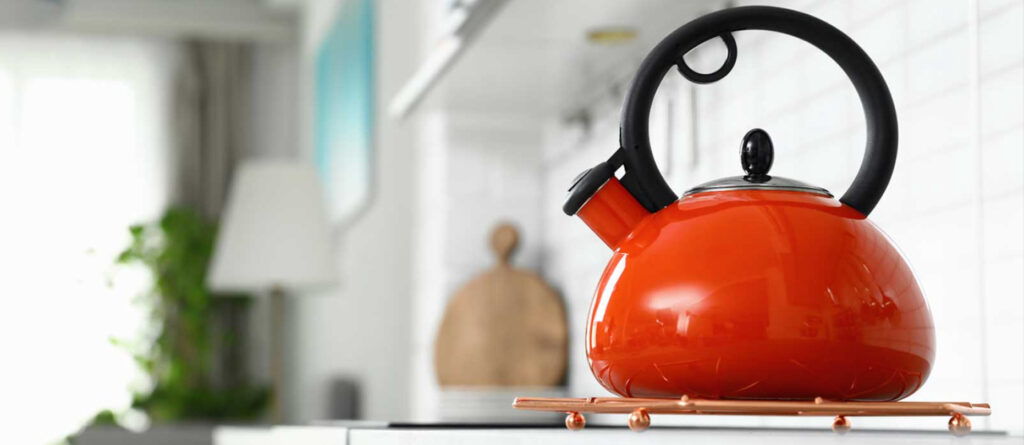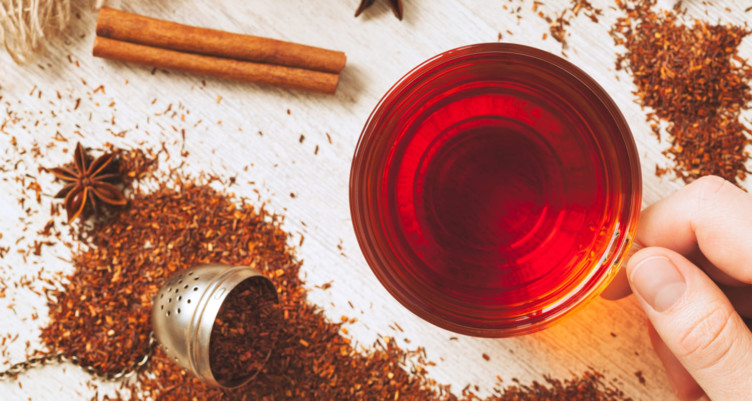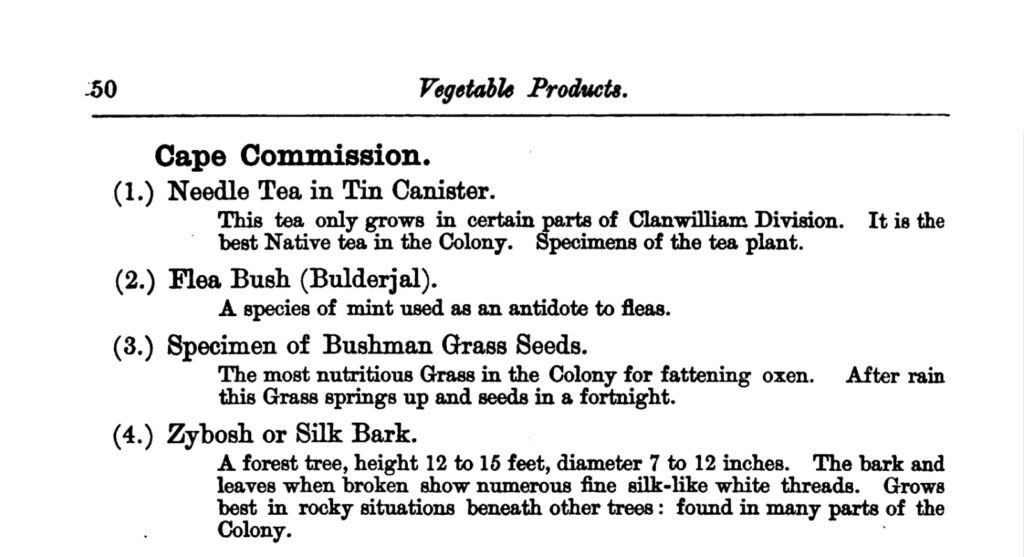In the competitive space of the tea market, rooibos has punched above its weight since coming to the attention of consumers wherever it has gained a foothold across the world. Driving its rise as a choice of popular beverage is a range of factors, many of which illustrate the ways rooibos provides benefit to consumers.
For leading tea buyers and beverage brands with an eye on changing tastes, these factors add up to reasons why rooibos is considered not as an outlier in terms of herbal tisanes, but rather as a valuable and versatile addition to their core product ranges. In this article, we unpack these factors, and how they have driven an interest in the marketplace that has been sustained for decades and continues to grow in today’s changing landscape.
What is rooibos, and why do consumers seek it out?
Rooibos is a tisane, or herbal tea. It is in the same class as infusions of chamomile, chrysanthemum, hibiscus, mate, peppermint or roasted barley. Although tisanes are not made from the Camellia sinensis plant, they may be even older than the ‘true teas’. Herbal teas were concocted in Ancient Egypt and Ancient China. By all accounts, they originated before the dawn of recorded history.
In the days of the Cape Colony from 1806 to 1870, tisanes were prepared from over fifty indigenous plants. Some of those beverages were valued for their pleasant flavour, others for their bitter tonic properties. Several local tisanes contained essential oils or held curative powers. A few Cape herbal teas produced a stimulating or calming effect. Of them all, few have enjoyed the growth in prominence in the global tea market that has marked the ascendancy of rooibos over the last 30 years.
In this colonial era, people in the Cape region of South Africa either replaced the expensive imported teas with these tisanes or blended them for economy. Throughout the nineteenth century, the foremost Cape herbal tea was honeybush. Like its distant relative, rooibos, it is caffeine-free.
Historically Rooibos was regarded as a simple everyday beverage with a simple taste. With time and once cultivation techniques have been perfected, rooibos terroirs will evolve to provide special flavours, fragrances and colours to the brew. To date, the differences have been slight and are not necessarily obvious to the average consumer, but this is a changing picture.
In recent years the cultivation and production of rooibos has seen improvements which are beginning to show results, with rooibos tea from the high-quality rooibos production region showing improvements in colour and flavour profile to the extent that differences can now be distinguished.
Scientists have found that the flavour of conventional (oxidised) rooibos reveals honey, and woody and floral notes with subtle astringency. The higher the quality, the more pronounced are the fruity aromas, the faintly sweet (almost caramel) taste, and the tawny colour. Top-grade rooibos is full-bodied: you hardly miss the tannin-and-caffeine kick of the Camellia sinensis tea.
This set of characteristics is one of the significant factors that have seen Rooibos increasingly taken up as an alternative to black tea; with a similar colour and a flavour profile that answers consumer interest, it makes for an excellent substitute – especially for consumers whose interests lie in the health benefits of their daily cuppa.
As well as being caffeine-free, the organoleptic properties of rooibos as an infusion stand out and have long attracted attention from tea brands across the world.
In terms of flavour, rooibos provides a rarely-matched versatility for use in a growing array of blends, and increasingly, ready-to-drink formulations. As a base flavour which lends itself to fruity and sweet pairings, rooibos has firmly established its place in a growing range of products worldwide. These include not only tea and herbal infusions, but also a growing number of alcoholic drinks, and food and confections. Added to this is its rich red colour, which provides the necessary visual appeal sought out by brands whose product ranges include iced teas and fruit teas, for which look as well as flavour act as selling points.
An additional factor that has lately gained the interest of some of the world’s most well-known tea brands is rooibos’ safety as a children’s beverage. Supporting this trend is a growing body of evidence that supports rooibos’ longstanding reputation as a beverage that provides health benefits to the consumers of all ages, including children and infants.
A growing association with health and wellness
Apart from the pleasant flavour, there are many reasons that consumer behaviour has increasingly trended toward making rooibos popular as an alternative to black tea.
Increasingly, one of the key drivers of interest is that it is seen as source of important health benefits. This has given rise to the endorsement of rooibos as the smart consumer’s choice of a health-giving alternative to tea by a number of prominent and influential figures.
This is why Gary Player, one of the four golfers in history to win the Grand Slam, has been its long-time champion. Johannesburg-born Player has led and promoted a healthy way of life. He likes to travel light, carrying only the necessities like his golf clubs and signature black outfits. But he always keeps a pack of rooibos in his suitcase.
Beyond sporting icons, some of the world’s most well-known screen personalities and celebrities continue to hype rooibos, and this is again as a result of its profile as being both caffeine-free and delicious to drink. Well-known actor Reese Witherspoon has punted it on Instagram, and America’s favourite surgeon, Dr Mehmet Oz, has also endorsed rooibos as a weight-loss ‘trick’ on his TV show. According to Oz, the inherently sweet beverage can help you shed one pound a week, as it ‘reduces your cravings naturally’.
“What I would do is replace whatever sugar you drink in your life with rooibos tea. One cup a day. That’s all I’m asking you to do.”
His friend Oprah Winfrey loves the South African tisane because it lacks caffeine. For Teavana, a Starbucks brand, she designed the Oprah Chai Latte, with rooibos tea as a main ingredient.
Simon le Bon, the lead singer of Duran Duran, likes a cup of rooibos before a performance to make his voice sound clearer. And so does Trevor Noah, the South African-born host of The Daily Show on Comedy Central.
In 2013, Noah injured his vocal chords during stand-up gigs in New York and had an emergency operation. That is why he took to sipping hot rooibos tea with ginger at his concerts. “People don’t believe me, but I really don’t have any specific rider”, he says, referring to his requirements when touring. “Some rooibos is a must, though. It’s really good for the throat.”
But there is much more to rooibos than the health benefits.
“A cup of delicious welcoming rooibos is as important to South Africa as tea is to Britain”, writes Jane Pettigrew, an award-winning British tea specialist. ‘”The brew refreshes, uplifts, calms and comforts. A little touch of magic in a cup!”
In 2010, the Nobel Peace Prize laureate and anti-apartheid activist Desmond Tutu retired from public life at the age of seventy-nine. He announced that, instead of rushing to conferences and giving speeches, he would spend his afternoons watching cricket on TV and sipping rooibos with his wife.
Indeed, many people prefer rooibos because of its gentle and soothing effect. You do not have to be an expert or celebrity to feel it. “Nothing like a cup of rooibos and Oprah to wind down a hectic day”, Linda Rizer, an American of Swaziland extraction, tweeted one evening.

Global renown helped by popular series of books
Thousands of people in the Western world learnt about this tisane thanks to Mma Ramotswe, the ‘Miss Marple of Botswana’. Rooibos is mentioned right in the opening paragraph of the earliest novel of The No 1 Ladies’ Detective Agency series. Among the few assets of the agency at the foot of Kgale Hill are a tiny van, an old typewriter and ‘a teapot, in which Mma Ramotswe — the only lady private detective in Botswana — brews rooibos tea. And three mugs — one for herself, one for her secretary, and one for the client.’
Mma Ramotswe, who first presented this beverage to her readers in 1998, drinks six to eight cups of piping hot rooibos a day and never travels into the bush without teabags. She empties her last cup around ten o’clock at night, instead of having a nightcap. For the ‘traditionally built’ investigator and her visitors, rooibos helps to restore ‘a sense of order and control into their disturbed universe’. The tea gives her time to think and may also lead her to the right decision.
The official Mma Ramotswe’s Cookbook elucidates that a cup of rooibos is ‘a temporary solution in many cases, helping clients to talk, putting them at their ease and taking their minds off their fears for a moment’.
The ‘father’ of Mma Ramotswe, novelist Alexander McCall Smith, was born in Bulawayo after World War 2. Although Rhodesia was a major export market for rooibos tea, his family did not drink rooibos. He became acquainted with rooibos later, through a friend who had lived in South Africa, and started drinking it. “I find it very refreshing”, McCall Smith says, “and I always have a supply in the house.”
In the 1980s, McCall Smith got to know Botswana, teaching law in Gaborone. On his return to Britain, he was appointed as professor at the University of Edinburgh. It was in Scotland that McCall Smith began his first book about the fictional African sleuth.
“I thought it would be a good idea to give Mma Ramotswe a particular tea to drink, and I decided on rooibos”, he says. “I am very glad that I did that, because I believe that it has introduced many people throughout the world to the benefits of rooibos tea.”

Ease of preparation
In the Rooibos Country, the original method of preparing this tisane would have been decoction, or stewing. This decoction served as a tonic, a ‘pick-me-up’ before a day at work.
Residents of the rooibos-growing areas know that the longer you let it draw, the stronger it becomes. Elsabé Kotzé, who grew up on a Cederberg farm in the 1940s-50s, remembers that a pot of rooibos tea was kept on the stove all day.
Ben-Erik van Wyk – who resided in Nieuwoudtville in the early 1970s – recounts that a kettle of rooibos rested on a simmer plate on the stove from morning to evening. ‘You added water and tea regularly and cleaned it up once a week’, he says. “The traditional tea was very strong. You can’t get that taste by infusing rooibos within a teabag.”
Decoction was also the traditional way of making rooibos in Wupperthal, in the Cederberg Mountains. Allan Kaplan – who first visited the rooibos-growing area in the 1950s – says that local people brewed rooibos leaves and pieces of branches in blackened pots over a fire, stirring it day after day.
Margaret Roberts, an authority on South African herbs, remembers how a man from the Rooibos Country taught her to make boeretee (farmer’s tea).
“He instructed me”, she wrote, “to make a pot at five in the morning and to leave it simmering on the stove until 9am. The first cup should be taken for breakfast after the cattle had been dipped. Then, at 11am another cup was refreshing and so on at intervals throughout the day, topping the pot with water every now and then! The best cup of all, with honey, was after dinner or just before bed, when the brew was so strong the teaspoon could almost stand up in it!”
To appeal to tea drinkers in other parts of the Cape, a quicker method was invented: infusion, or steeping. A teaspoonful of rooibos leaves was soaked in a small amount of boiling water for half a minute. Then the water was drained off to get rid of the ‘wild’ taste. After that, the cup was filled with boiling water and steeped for fifteen minutes. People took it hot, with milk or a slice of lemon, or iced.
Later, the cultivation improved. Thanks to the significant experimentation of early rooibos pioneers, and in recent years serious scientific investigation into the chemistry of the rooibos plant by producers, the technique of oxidising rooibos has been perfected. This is why good quality rooibos tea no longer has a hay-like, musty aftertaste.
Unlike lower-quality products of bygone years, there is no longer a need to draw off the first infusion, as rooibos drinkers used to once do. Besides this, the technique of brewing a cup of rooibos tea has remained the same, and this ease of preparation has again been a significant factor in its inclusion in leading tea brands’ product ranges.

A sought-after ingredient: beyond rooibos tea
Since the 1960s, rooibos has been part of other beverages such as fruit punches, cocktails and syrups, and been used even in food recipes. For instance, rooibos ice cream was served at Catherine Zeta-Jones and Michael Douglas’s wedding.
Annekie Theron, a famous promoter of rooibos’ health benefits, used to cook meat in a rooibos tea infusion. It made her stews and oxtail tender and juicy. Rooibos also imparted its rich mahogany colour to her sauces and gravy.
The most comprehensive source of ideas on culinary uses of rooibos tea is an illustrated recipe book published by Rooibos Ltd, the largest supplier of rooibos. It contains more than a hundred sweet and savoury dishes created by South Africa’s fourteen leading chefs.
The versatility of this tisane is amazing. Cold infusions can soothe tired and red eyes or irritated skin; rinsing dark hair with rooibos gives it a beautiful shine; and burning rooibos tea can keep flies away from from the kitchen.
Margaret Roberts, who has been fascinated by rooibos since the 1960s, found a place for it in her model garden. ‘Instead of throwing away your used rooibos tea leaves or bags, use them along with other vegetable and fruit peelings to make a balanced compost mix’, she says. This tea is a natural fertiliser, because it has nutrients and minerals that encourage plant growth.
From its humble country origins, to becoming the favourite of luminaries the world over – and on to its incorporation into healthy diets through a variety of dishes and preparations – the benefits of rooibos to the consumer have become well established. As interest in rooibos grows, the combination of personal experiences and the body of evidence point toward rooibos answering interest in health and wellness, and this in turn fuelling consumer interest.
With these factors raising the profile of rooibos as an alternative to conventional beverages such as tea and coffee, the prospect for tea brands seems clear. Far from being a trend, rooibos is now firmly entrenched as a feature in the tea category, and looks set to grow in appeal and market segment.
This article is an extract of ‘The Rooibos Story‘ by researcher Boris Gorelik and is published with the kind permission of the South African Rooibos Council.
Related articles here on our website provide tea buyers and brands with a great number of insights into various aspects of rooibos, including the industry, its health benefits to consumers and the global marketplace.


